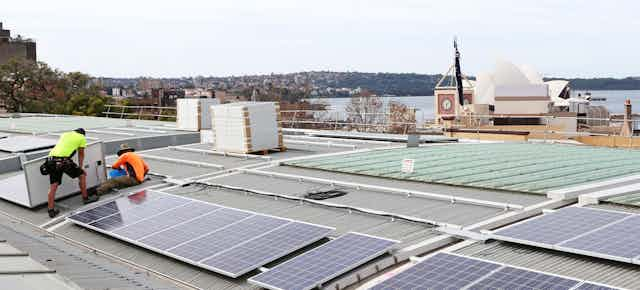This is the first piece in our new Three Charts series, in which we aim to highlight interesting trends in three simple charts.
Australia is embarking on a transition from an electricity system that relies largely on coal to one that may one day be 100% renewable. Last week’s closure of the Hazelwood coal-fired generator was an important milestone on this path.
The development of the renewables sector has not, however, been a smooth ride.
Estimates released by the Australian Bureau of Statistics suggest that the number of direct full-time equivalent jobs in renewable energy activities has continued to fall from its 2011-12 peak. Over a period in which the Australian economy saw around 600,000 additional people get jobs, employment in the renewables sector has been going backwards.
A small employer
The renewables sector is estimated to have directly provided only 11,150 full-time equivalent jobs in 2015-16. The Australian labour force exceeds 12.6 million people. The sector thus makes a small contribution to national employment, although one that is quite important in some local economies.
Around half of the jobs in renewables in 2015-16 were in installing (and maintaining) rooftop solar systems. Hydroelectricity generation provides 1,840 full-time equivalent jobs, a number that is likely to increase if pumped storage is to make a larger contribution to smoothing Australia’s electricity supply. Biomass provides 1,430 full-time jobs, and the wind industry around 620.
The fact that renewables is a small employer - especially once installations are up and running - is not a bad thing. If renewables were labour-intensive, they would be expensive.
Up then down
The rise and then fall in renewables jobs is primarily a result of what has happened to installations of rooftop solar. The annual number of small-scale solar installations (PV and solar water heaters) skyrocketed over the four years to 2011. This rapid growth was spurred by generous feed-in-tariffs, rebates, and rules for federal government solar credits. There was also a national program to install solar panels on schools.
When these arrangements were curtailed, uptake fell. Annual installations of small-scale solar PV and water heaters are down by more than 60% from their peak. We are still installing a lot of new systems (more than 183,000 in 2016), but fewer than before. Employment estimates for small-scale solar closely track installation rates. The decline in employment in the wind energy sector is also worth noting.
The largest fall in renewables jobs has been in Queensland, a state that substantially tightened its feed-in-tariff scheme for rooftop solar in several steps from 2011 on. Queensland also holds the title of having Australia’s highest residential rooftop solar PV penetration rate (32%). South Australia is not far behind, at 31%.
Ramping up large-scale renewables
Recent years of policy uncertainty and backtracking have not helped the rollout of large-scale renewables. The termination of Australia’s carbon price and downwards renegotiation of the Renewable Energy Target had chilling effects on investment.
Those events are now behind us. With continued reductions in the cost of renewables, brighter days for the sector appear to be ahead, especially if our governments get policy settings right.
We can expect particularly rapid growth in jobs installing large-scale solar PV. Just last week, for example, it was announced that South Australia is to have a large new solar farm.

